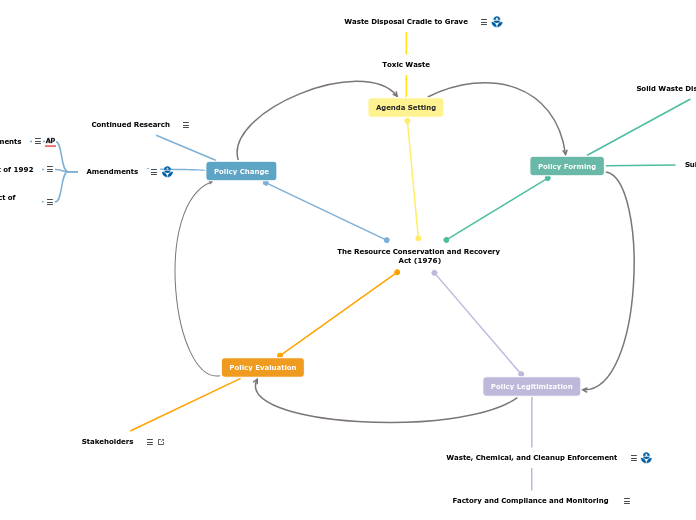The Resource Conservation and Recovery Act (1976)
Agenda Setting
Toxic Waste
Waste Disposal Cradle to Grave
With more awareness of bad toxic waste disposal practices, their became an observed need not just to regulate toxic waste in the disposal process but also in the substances generation all the way to disposal. It was seen that toxic waste does not become a problem or can negatively impact things during the disposal process but that regulation is important cradle to grave. Solid waste disposal was seen as something that needed to be regulated because of the increase in amounts, and this act helped bring together both hazardous and non-hazardous wastehttps://www.epa.gov/history/epa-history-resource-conservation-and-recovery-act
Policy Forming
Solid Waste Disposal Act Amendment
The RCRA was an amendment to the Solid Waste Disposal act of 1965. Because of the increased awareness of toxic waste, RCRA as an amendment addresses solid waste and toxic waste.
Subtitles
https://www.epa.gov/rcra/resource-conservation-and-recovery-act-rcra-overview
Subtitle C
Hazardous WasteCradle to grave processCompanies and corporations with factories programs need to be implemented on how to handle hazardous waste cradle to grave
Subtitle D
Non-hazardous WasteThis deals with regulations on bad disposal of solid waste such as dumping and puts specificity on location, amount and what kind of waste is being disposed, etc. Even though this solid waste isn't hazardous, improper disposal still negatively impacts people and the environment
Policy Evaluation
Stakeholders
Stakeholders such as people in of power in local and state communities as well as different land owners, companies, and corporations are the ones that are able to push for changes. This can specifically be seen through the amendments in which the first and third differ from each other.Scientists helped evaluate specifically changes in policy because of land disposal and improper lining of disposal dump areas. There were shown to be sorts of loopholes for companies to not truly dispose of waste correctly without truly being held responsible and. given appropriate consequences. With this evaluation though, amendments and alterations were made not just because of scientists but people that deserved fair disposal and the effectiveness has greatly increased. https://digitalcommons.pace.edu/cgi/viewcontent.cgi?referer=&httpsredir=1&article=1196&context=pelr Companies and corporations evaluate what is doable for them under specific regulations and requirements.
aPolicy Change
Amendments
There have been three amendments to the act so far.https://www.epa.gov/rcra/history-resource-conservation-and-recovery-act-rcra#historyConcerning effectiveness, through evaluation there were shown to be loopholes in which the amendments and increased regulatory power helped to impact. https://digitalcommons.pace.edu/cgi/viewcontent.cgi?referer=&httpsredir=1&article=1196&context=pelr
aHazardous and Solid Waste Amendments
The first amendment was to phase out specifically land disposal of hazardous waste and to create a process for corrective action.This can show enforcement for big companies that do not properly dispose of their solid land waste or hazardous waste. Just recently UPS was fined for not precisely land disposing of hazardous or compromised packages. https://apnews.com/article/trending-news-puerto-rico-business-government-and-politics-hazardous-waste-d3cee4c991eada888899ea62b47ef389
Federal Facility Compliance Act of 1992
This amendment strengthened the power of the EPA to enforce the regulations and requirements specifically in federal facilities.
Land Disposal Program Flexibility Act of 1996
This amendment interestingly created forms of flexibility for certain situations in which there can be land disposal.
Continued Research
There is continued research on:good practices for toxic waste disposal impact of improper waste disposal for both toxic and non-toxic waste impacts of effectiveness government regulations and consequences
Policy Legitimization
Waste, Chemical, and Cleanup Enforcement
The act has specific requirements and practices for waste disposal, chemical enforcement, and cleanup enforcement. For waste disposal, that is where the specific compliance and monitoring comes in for hazardous and toxic waste disposalFor chemical enforcement, there are specific guidelines and requirements that facilities have to stay within. What those are differ based on what the facility is dealing with. There are specific measures for pesticides, toxic chemicals, PCBs, Emergency Planning and Right to Know.For clean-up, there are corrective action programs as well as guidelines under superfund. there is also the enforcement of liability if best practices are not followed https://www.epa.gov/enforcement/waste-chemical-and-cleanup-enforcement
Factory and Compliance and Monitoring
Compliance and monitoring of the generation, life cycle, and disposal of wastes.Allows for the EPA to inspect facilities to ensure they are following best practices.Also allows for investigations to be held for corp. and factories that may not meet these required practices and safety guidelines Monitoring is done for both hazardous waste and non-hazardous solid waste
